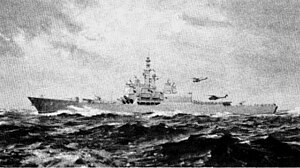The strike cruiser (proposed hull designator: CSGN) was a proposal from DARPA for a class of cruisers in the late 1970s. The proposal was for the Strike Cruiser to be a guided missile attack cruiser with a displacement of around 17,200 long tons (17,500 t), armed and equipped with the Aegis combat system, the SM-2, Harpoon anti-ship missile, the Tomahawk missile, and the Mk71 8-inch gun.
 Artist conception of Mark I variant (1976 version)
| |
| Class overview | |
|---|---|
| Name | Nuclear-powered guided missile strike cruiser (CSGN) |
| Builders | Never built |
| Operators | |
| Preceded by | Virginia class |
| Succeeded by | Ticonderoga class |
| Cost | $1.371 billion USD - lead ship (est.) |
| Planned | 8–12 |
| General characteristics | |
| Type | Guided-missile cruiser |
| Displacement |
|
| Length | 709 ft 7 in (216.28 m) |
| Beam | 76 ft 5 in (23.29 m) |
| Draft | 22 ft 4 in (6.81 m) |
| Propulsion |
|
| Speed | 30 knots (56 km/h)+ |
| Range | unlimited |
| Complement | 454 (total) |
| Sensors and processing systems | |
| Armament |
|
| Aircraft carried | 2 x SH-2F LAMPS I helicopters |
A prototype strike cruiser was to be the refurbished USS Long Beach; at a cost of roughly $800 million, however this never came to pass.

Originally, eight to twelve strike cruisers were projected. The class would have been complemented by the Aegis-equipped fleet defense (DDG-47) version of the Spruance-class destroyer. Plagued with design difficulties and escalating cost, the project was canceled in the closing days of the Ford administration.[1] After the cancellation of the class, the Aegis destroyers were expanded into the Ticonderoga class (CG-47) Aegis cruiser program.
See also
editNotes
edit- ^ Friedman, Norman (1984). U.S. CRUISERS An Illustrated Design History. Annapolis, Maryland: Naval Institute Press. pp. 419–422.
External links
edit- Letters to Antiwar.com
- Strike Cruiser (CSGN)- GlobalSecurity.org
- Statement by Ronald O'Rourke before the House Armed Services Committee, 6 April 2006
- CSGN-1 "Strike Cruiser" class - Harpoon HQ
- Shipbucket.com:
- USS Long Beach CSGN Refit Archived 15 August 2014 at the Wayback Machine
- CGN-42-class CSGN Archived 15 August 2014 at the Wayback Machine
- CGN-42-class CSGN Archived 15 August 2014 at the Wayback Machine
- 1974 CSGN Archived 15 August 2014 at the Wayback Machine
- 1974 CSGN Archived 15 August 2014 at the Wayback Machine
- 1976 CSGN Archived 15 August 2014 at the Wayback Machine
- Photobucket - Shipbucket: